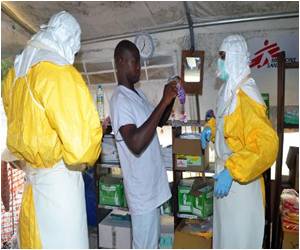
To help contain the current outbreak, experts say that surveillance remains key. Detecting viral RNA genomes in suspected fever patients helps confirm diagnoses of Ebola, and aids decisions to quarantine patients and begin tracing their contacts. Yet sequencing viral genomes directly from blood samples holds many challenges. Samples contain very little viral RNA and are heavily contaminated with human RNA, while hot climates cause rapid degradation of viral RNA material and biosafety measures bring further complications for handling samples. As such few Ebola genomes have been sequenced.
Research led by the Broad Institute, USA, has now revealed a new method to sequence genomes of the Ebola virus, that lowers contaminating human RNA from 80% to less than 0.5%, and was proven to work through the rapid sequencing of nearly 100 Ebola patient blood samples from the current outbreak, with a turnaround time of 10 days. The method is also cost-effective, and may help West African nations rapidly and effectively track outbreaks with limited resources.
The research team was initially developing a method for sequencing Lassa virus that causes hemorrhagic fever prevalent in West Africa. They were able to define a laboratory procedure using enzymes and chemical reagents which led to almost complete removal of contaminant human RNA from their Lassa fever samples. Once the Ebola outbreak spread to their research site in Sierra Leone, they were asked to put their newly developed sequencing method to the test.
Using their improved sequencing approach, the team processed samples from 78 Ebola patients and reduced the normal length of the process threefold. Their method also lowered costs by allowing them to sequence and assemble more viral genomes using fewer steps with a higher success rate.
Lead author Christian Matranga from the Broad Institute said: "We were surprised that our strategy worked so well with such diverse, and often difficult samples of undefined quality and quantity. And because of the speed of our approach, we were rapidly able to make the viral genetic data available to the scientific community to provide timely insights for ongoing surveillance and control efforts in the area."
Advertisement
The tools and protocols that the team have developed are now being shared to enable laboratories in West Africa and around the world to rapidly sequence clinical samples from Ebola patients to inform their outbreak response.
Advertisement
Pardis Sabeti from the Broad Institute, co-senior author on the study, said: "We are thrilled to be able to share our protocols with the scientific community. We hope that many labs around the world will soon be generating critical Ebola sequence data to aid the outbreak response. We are especially pleased that our outstanding collaborators in West Africa will soon be leading this effort. "
Andi Gnerke from the Broad Institute, co-senior author on the study said: "The Broad has been deeply committed to developing tools to sequence many RNA viruses over the years including HIV, Dengue, RSV, and HCV. We were very happy that these approaches could have an impact on the devastating viruses Lassa and Ebola."
Christian Matranga added: "Since the cost of preparation and sequencing is relatively low, and samples are the most precious commodity, our approach provides a great initial strategy for sequencing viral samples. These methods are universal and can be used with any viral RNA sample. They have the potential to rapidly provide informative reads, and could also help unlock difficult samples that have yet to be prepared or sequenced poorly by traditional methods. We have expanded our collaborations to ensure that those sequencing new Ebola cases are using a similar strategy. We are currently training individuals from federal and international agencies as well as groups in West Africa on our approach, and to enable labs to do their own viral RNA sequencing."
Source-Eurekalert










